Marketers should pay more attention to attention
There’s ample evidence that longer dwell time on ads raises brand recall and choice, so ignore Byron Sharp’s claims that you shouldn’t pay for more attention.
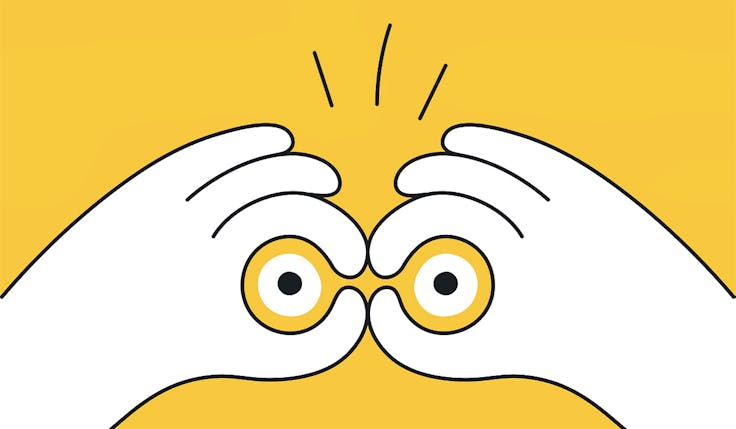
An interesting debate is springing up around attention, thanks to Professor Byron Sharp. A couple of weeks ago Sharp was coaxed from the towers of the Ehrenberg-Bass Institute to Sydney. At the Mi3-LinkedIn B2B Next conference he delivered his usual evidence-led insights into all manner of marketing things.
Ehrenberg-Bass has much to say about advertising media. Sharp was quick to remind his Sydney audience of the two “golden rules” that the Institute advises clients to follow. “First, you have to reach everyone in the category… and spread your budget across timeslots, across locations.”
Mass reach and always on. Clear. But when questioned about attention, things got more interesting and animated.
“Our job is to get some attention,” Sharp agreed. “I don’t want to do advertising and not be seen. But after that, paying for a lot more? No.”
Sharp cited a bus shelter ad, and the two seconds it takes to get the message. “Am I just going to look at the bus shelter ad for 10 seconds? Would I need to? No, so don’t be suckered in. It’s just the old engagement thing: ‘We need to get engagement with our consumers!’ No, you don’t.”
Except Sharp is wrong. About the value of attention in general. And about the specific need to engage with audiences more to ensure longer periods of attention. There is a growing accumulation of evidence from the likes of Lumen, Dentsu and the inestimable Professor Karen Nelson-Field to demonstrate the point. And it’s crucial that marketers are following the debate, because it has major implications for what they do.
Zero viewability
Where everyone, including Sharp, is aligned is in the value of viewability. Obviously, when Sharp espouses reach he means ads that not only exist, but which engage (even on the most fleeting level) with their target audience to achieve attention. ‘Fixation’ is the official term for this. It means that a consumer’s eye rested on an ad for 100 milliseconds – a tenth of a second or more.
Without fixation, you cannot truly say you have reached a target consumer. That might sound an obvious assertion; if you told your dad you’d just read a Marketing Week column that claims ads only work if you see them first, he would concur then question (once again) the value of your profession. But it’s not an obvious point to those befuddled and besmirched by industry bollocks over the last decade. We have lived through an era in which various besuited figures have stood on colourful stages talking total wank about amazing new media possibilities without even a bullet point of hesitancy to note that quite a lot of the media they espouse is impossible to see.
Marketers spend billions on ads that run but which are never viewed because consumers simply cannot access them. Ads that run further down the page than we ever venture. Or which play while hidden behind another ad. Or which don’t appear on the digital billboard during the fleeting period when we drive past. All lost to the unseen-tree-falling oblivion of non-viewability.
And the key point is that non-viewability is not an evenly distributed constraint. Take mobile web advertising where, according to Lumen research (below), more than a third of the formats are unviewable to audiences.
Unviewable ads are, as former Unilever CMO Keith Weed so brilliantly put it, like having your billboards underwater. A complete waste of money. So complete that even the industrial digital marketing complex cannot justify or obfuscate the point.
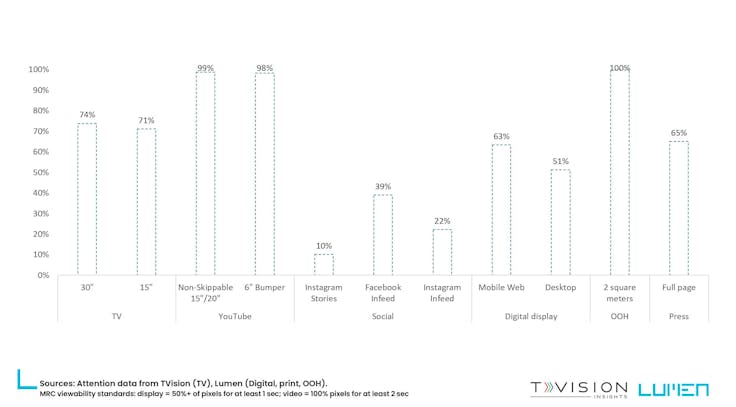
But viewability is not the ultimate objective, merely the first step on the road to effectiveness. The next, bigger step in the attention journey is the one that moves from a viewable ad to one actually viewed by its target audience.
Until relatively recently, the media industry traded on opportunities to see rather than the actual number of people viewing an ad because, while agencies might estimate how many people passed a billboard, watched TV or had an ad appear on their phone, they had no sure way of calculating the proportion that looked at it during this ‘opportunity’. This is where research firm Lumen has mined an amazing array of data over the last decade.
I remember eye-tracking experiments from the 1980s: each produced interesting data but, regarding naturalism, required a total suspension of disbelief because the subjects first had to don a motorcycle helmet with a large camera mounted on top of it. They were then asked to relax, forget about the helmet and read the newspaper. Lumen’s big breakthrough was putting the trackers on the media being viewed – rather than the market, as they viewed – thus opening a treasure trove of new and increasingly exciting insights about media and the attention we do and don’t pay to it.
Specifically, Lumen can measure fixation – the proportion of consumers who actually view an ad. By combining viewability (whether the ad is potentially visible) with view averages (the proportion of viewable ads that achieve fixation), we can arrive at a much clearer picture of what we could refer to as ‘actual reach’. I love this data – shown below.
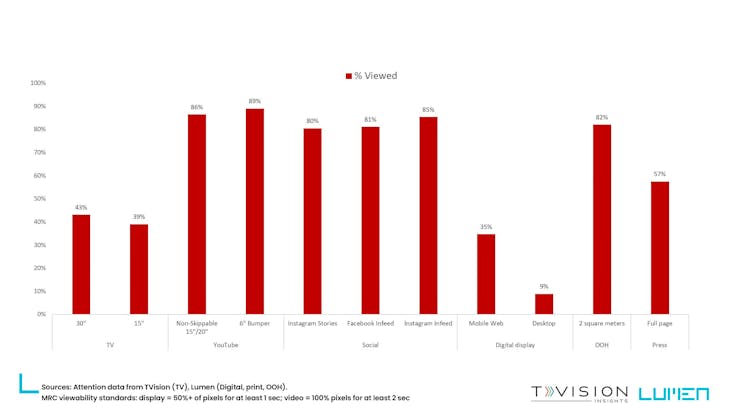
If you pay for the average 300 x 600 digital display ad on a mobile phone, its viewability is not too bad – 63%. But only 35% of the target audience will actually look, even for a few milliseconds, upon that ad. In contrast, a large, static billboard on the walk home achieves 100% viewability (provided it’s not digital) and will be seen by an average of 82% of the audience.
While both media might claim to ‘reach’ 1,000 target customers, the mobile ad is seen by 350, the billboard by 820. That’s partly because the outdoor ad is more viewable in the first place and partly because its size, location and context of reception all garner more attention. Before we go too far into digital media-bashing we should note that the price of a large outdoor ad is significantly greater (for the most part) than a bit of digital display.
Beyond fixation: dwell time
While it’s worth pointing out the gigantic disparities between claimed reach and actual attention across different media, no-one disagrees with the fundamental contention that you need attention to achieve any effect. Where Sharp went wrong was his assertion that marketers are “suckers” if they think more attention is more valuable – especially if that focus on more attention comes at the cost of Ehrenberg-Bass’s first golden rule: that of maximum reach.
To understand the error, we must ask two questions of the data. First, does dwell time differ across different advertising media in a significant manner? Second, does extended dwell time have any significant impact on advertising effect.
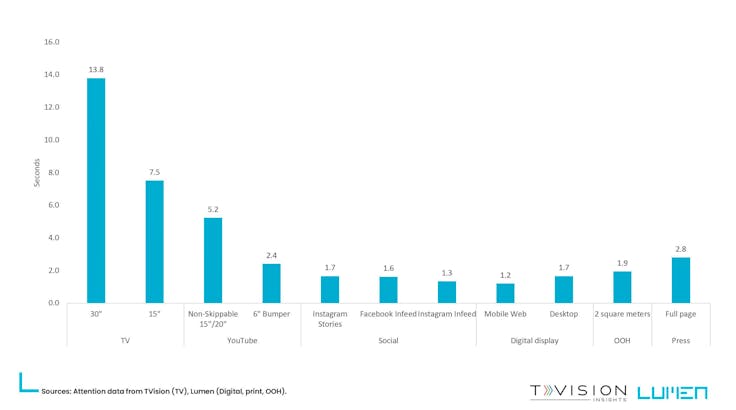
The answer to the first question is a resounding yes. Average dwell time varies tremendously across the different media options.
In our earlier example, we saw that our mobile ad was only seen by 350 people, whereas our outdoor ad achieved attention from 820. But once someone’s eyes alight on an ad, the dwell time is also significantly different. Those 350 mobile phone users will likely look at the ad on their phone for a further 1.2 seconds. The 820 pedestrians walking along the pavement will spend an average of 1.9 seconds looking at the billboard.
But does the difference matter? Does double or triple the attention length make any meaningful difference to an ad’s impact? Here, again, there is a definitive, evidence-based – dare I say it, scientific – answer. And that answer is: “Yes!”
Media agency Dentsu is leading in the area of attention measurement and applying the subsequent lessons to the practical business of media planning and buying. The agency’s global team, headed by Clive Record, spent three years working with Lumen and several other research firms assessing the impact of attention on effectiveness.
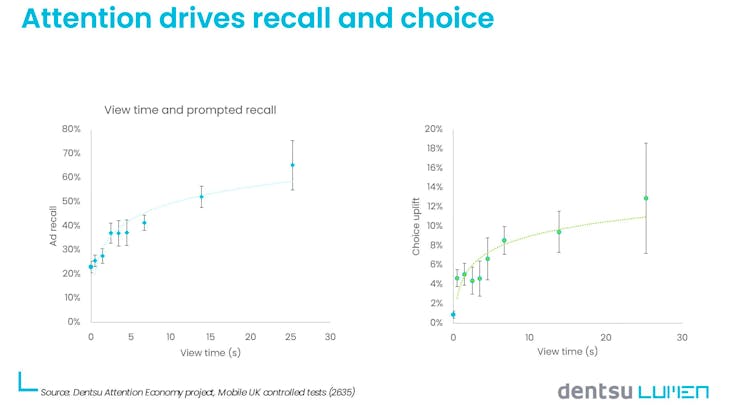
Across multiple robust experiments in the UK, US and Australia using different brands, Dentsu shows a clear, statistically significant link between dwell time and prompted recall. A two-second dwell time, for example, translates to 28% prompted recall, in which consumers remember both the ad and the brand behind the ad. But if you increase the dwell time to 14 seconds, you almost double the prompted recall. The same ad delivers twice the impact if dwell time increases.
It’s a similar story for preference. Consumers who look at an ad for just two seconds have only a 5% increase in brand choice, compared to those in a control group who did not see the ad at all. But if the audience dwells on that same ad for longer, that uplift increases significantly. A 14-second dwell time delivers a 9% uplift in choice. More dwell time delivers better top- and bottom-of-the-funnel impact. Attention matters.
The importance of attention
The growing attention to attention within advertising is an important and evolving area. Clearly, some advertising can work with the barest flash of fixation. But extending that attention to include dwell time also has significant ramifications. That means any wholesale dismissal of attention research is a grave error.
That’s partly because attention is so variant across different media and different formats within each media. Too often, advertisers have conflated reach with opportunities to see and spent their marketing budgets inefficiently. Marketers need to take more care with their money.
Running an ad is not the same as consumers being exposed to it. Reach is not actual reach. An opportunity to see is not seeing. And, as Mike Follett, the founder of Lumen, likes to say, if you are buying CPM (cost per thousand) it makes sense to ask not only what the C is but also what the M actually consists of too. The answer is often variant, unreliable, unclear, problematic. The question is often unasked.
But it’s also an important new area in marketing because attention is not a binary variable, irrespective of what Ehrenberg-Bass might try to tell us. Simply reaching or not reaching a target customer is not the end of it. To make that assumption would be oversimplistic at best and dogmatic at worst.
More attention in the form of extended dwell time is not a sucker’s objective, quite the reverse. It can have a significant impact on whether your brand achieves salience and whether preference eventuates.
The marketer as bartender
As much as I respect the Ehrenberg-Bass Institute and have learned from its thinkers, I also grow weary of their inability to acknowledge or accept theories that did not originate within their own four walls.
The Institute has given us so much in the last decade, not only in advancing marketing thinking but, in several audacious instances (salience, targeting, rigour), revolutionising the way good marketers do things. I doff my disciplinary cap to its team and to the Great Byron, who truly is the best of us.
But as much as he and they can be amazingly right, they, like all marketers, are also often wrong. I say that not to critique Professor Sharp and his colleagues, but as a callout to the wider throng of advocates who trumpet every utterance from Ehrenberg-Bass as infallible, objective fact.
That does not mean marketers should ignore the insights of Ehrenberg-Bass but, more generally, they need to move away from this oversimplistic notion of marketing laws set in stone by a priest atop the temple. Instead, see yourself as a bartender. A mixer of drinks. Turn to Ehrenberg-Bass for some of your cocktails but be open to other thinkers – those in the attention field, for example – for equally robust and enticing options. Even blend them together when you see fit too. If you’ve spent any time propping up a decent cocktail bar, you will know that the secret of any bartender’s success is to master as many source drinks as possible, and to then mix and match according to the situation and client.
Build your own knowledge of marketing from those who went before, around and against you. And pay attention to attention, it’s a bigger topic than some would have you believe.
Mark Ritson is the 2023 PPA Columnist of the Year and teaches marketing strategy on the Mini MBA in Marketing. Ritson will be on stage at the Festival of Marketing on 6 October, inviting the audience to score their own marketing capability with 10 tests of their current approach. Find out more here.








Attention, reach, frequency, dwell time and viewability are all proxies for the real thing that everyone really wants and needs to measure – ad effectiveness – e.g. uplift in sales / downloads / account openings etc.
As brands could not measure the actual effectiveness of their cross media campaigns and get a granular understanding of the performance of each medium, they use proxies such as the above. While this is important, it is not enough for several reasons:
1) The way they look at attention is too simplistic – attention in these studied is measured by eye movement and where your eyes rest – while this may be true for a display or OOH ad, it is not true for a TV or video ad that has sound – research shows that TV ads are more effective when people are second screening and their eyes are on their mobile. While their eyes are on the phone, they still hear the audio so it would be wrong to assume they did not pay attention to the ad.
2) While attention is important it could also be negative – people will probably pay more attention to ads that annoy them. So while attention may serve as a proxy, it is important to remember that it is not enough, in the same way that a campaign that has a reach of 95% within the target audience, doesn’t mean it will be effective and increase actual sales. This is why attention, like reach is only one part of what really needs to be measured – actual effectiveness. Once brands understand the effectiveness of their campaign, they can go deeper and see how it can be improved – do you need to increase reach, frequency, attention etc.
3) Another problem with this data is that when looking at the importance of attention it is critical to go beyond soft measures such as brand recall or brand preference and look at the effect on harder KPIs such as sales. In order to prove the importance of attention the research has to close the loop and see the effect on the hard KPIs.
Until recently, it was impossible to measure the actual effectiveness of the campaign and the effect each media has on sales. For this reason brands focused on measuring the things that were possible to measure – reach, frequency, viewability or attention. Recent developments in measurement technologies, enable brands to use single-source data (which measures an individual’s TV, online and other media exposure, alongside purchase behaviour and location data over time) and see how their campaign has performed – understand the uplift from each part of the campaign.
Only by measuring the actual effectiveness, we can fully understand the importance of each proxy and be able to really optimise our campaigns.
Byron is even more wrong than you know! His recommendation about optimal media plans comes from someone who refuses to measure media effectiveness! His implicit assumption that the Bayesian priors are all equal that any category buyer will convert in the face of ad exposure is absolute nonsense. the prior exectation of response is mathematically related to the baseline probabiity of purchase for that consumer (think first derivative of the logit function.) I now have 5 out of 5 solid case studies that prove this empirically. Regarding attentiveness to advertising, there is a piece that marketers often miss there as well. Attentiveness is not purely a function of copy quality: it is the handoff between marketer and consumer in the ad effects ladder. It takes a consumer who is interested in your message to pay attention. This is highly driven by need state and brand propensity. both factors are targetable considerations. In my research with Viant, NCS and now the MMA I have shown that the right target of consumers can repeatedly produce 16 TIMES the ROAS of other consumers. So target away! Do it right and you will outperform those who prefer Byron’s leaps of faith about how marketing produces incrementality.